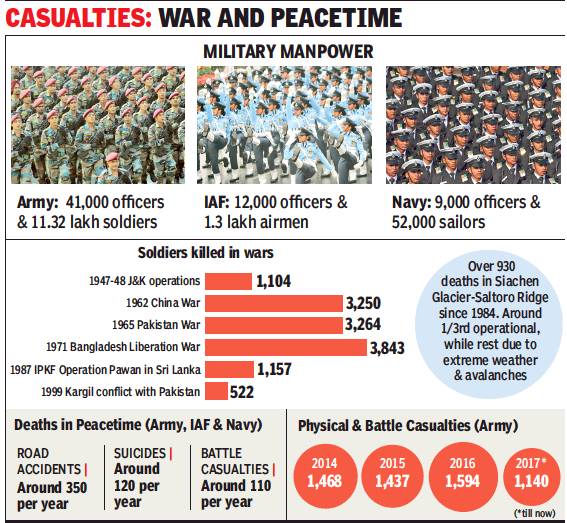Defence Services, India: Wartime, peacetime casualties after 1947
This is a collection of articles archived for the excellence of their content. |
Contents |
Deaths during peacetime
2005-2017
The 1.4 million strong Indian Army lost a soldier every third day in the line of duty over the last 13 years. Data available with the Army shows that between January 2005 and December 2017, a total 1,684 men were killed in ceasefire violations by Pakistan, or while engaged in antiterrorist and counter-insurgency operations. Other actions in which deaths occurred were offensive tactical missions and peacekeeping missions.
According to data released on January 15 on the 70th Army Day, 87 Indian soldiers, including seven officers of infantry, artillery, engineers, signals, Army air defence, Army Services Corps and Corps of Electronics and Mechanical Engineers laid down their lives in different parts of the country in 2017. On December 23 last year, four more deaths, including that of a major, were reported from along the Line of Control, which took the figure to 91.
In 2016, 86 Army men, including 11officers, were killed in action, while in 2015 it was 85 men including four officers. In 2014, 65 officers and men were killed, while the casualty figures were 64 in 2013, 75 in 2012, 71 in 2011, 187 in 2010, 107 in 2009, 71 in 2008 and 221in 2007. In 2006, 223 men and officers were killed. A year previous to that, the number of casualties was 342, which was the highest over these 13 years.
On December 23, a major and three soldiers were
killed in unprovoked firing on Indian posts along the Line of Control in Keri sector of Jammu’s Rajouri district. The men were identified as Maj P A Moharkar, Lance naiks Gurmail Singh and Kuldeep Singh and Sepoy Pargat Singh.
Apart from these, the latest operational casualty was reported from along the Line of Control in Jammu & Kashmir’s Rajouri district, in which Lance Naik Yogesh Muralidhar Bhadane was killed on Saturday after sustaining severe injuries during a ceasefire violation by Pakistan Army.
2014-17

Defence services peacetime casualties, 2014-17
From: Rajat Pandit, Accidents, suicides, ailments kill 1,600 soldiers every year, December 3, 2017: The Times of India
See graphic:
Defence services wartime casualties, 1947-1999; Defence services peacetime casualties, 2014-17
Without going to war, India loses around 1,600 military personnel every year. And the single biggest killers are road accidents and suicides, much more than counter-insurgency operations or firing duels with Pakistan along the Line of Control in Jammu and Kashmir.
Latest figures collated by TOI show that road accidents claim the lives of over 350 soldiers, sailors and airmen every year, while another 120 personnel take the extreme step of committing suicide. Other big causes are training accidents and various health reasons, which itself is a big worry for the forces that are supposed to be fighting fit.
India does have the dubious distinction of recording the highest number of road deaths in the world, as also one of the highest suicide rates, but the same being reflected in the highlydisciplined and trained environs of the armed forces is alarming for many.
The Army, Navy and IAF have lost over 6,500 personnel just since 2014. The highest toll, of course, is found in the 11.73-lakh strong Army, which dwarfs the IAF and Navy in terms of sheer manpower.
“Physical casualties” are more than 12 times the number of “battle casualties” in the Army. If the force recorded 112 fatal battle casualties in border skirmishes, shelling, counter-insurgency operations and operational accidents in “notified areas” in 2016, it lost over 1,480 soldiers due to physical casualties.
This year, the battle casualties in Army have just about crossed 80 till now, while the physical casualties have already touched 1,060.
Sources say Army chief General Bipin Rawat last month expressed concern about his force losing “nearly two battalions (each battalion has 700-800 soldiers) worth of personnel every year” due to physical casualties. “He has stressed the urgent need to address this issue…new measures are being put in place, while the older ones are being fine-tuned,” said an officer.
Road accidents remain a big worry. A series of directives have been issued for proper training of drivers, regular monitoring and medical fitness tests, and strict punishing of errant or negligent behaviour.
“Night driving, if not operationally required, is also being discouraged. But the Army is also huge in terms of manpower, with massive vehicular movement in difficult terrains around the country every day,” said a senior officer.
Stress-related deaths like suicides and fratricide (to kill a fellow soldier or superior) also take a huge toll. Over 330 soldiers, including nine officers and 19 junior commissioned officers, have committed suicide since 2014. There have also been a dozen cases of fratricide in the timeframe.
Suicide cases in the armed forces have showed no signs of reducing despite all the so-called measures being undertaken to reduce stress among soldiers, airmen and sailors deployed in far-flung areas away from their families, as earlier reported by TOI.
Soldiers undergo mental stress for not being able to take care of the problems being faced by their families back home, which could range from property disputes and harassment by anti-social elements to financial and marital problems.
Prolonged deployment in counter-insurgency operations in J&K and north-east also takes a toll on the physical and mental endurance of soldiers. All this is also compounded by relatively poor salaries, denial of leave, lack of basic amenities and ineffectual leadership.
Measures being implemented to stem this trend range from provision of mental counselling and improvement in living and working conditions to provision of additional family accommodation, a liberalised leave policy and strengthening of grievance redressal mechanisms.
2018
See graphic, ' Indian Army officers and jawans: martyrs who made the supreme sacrifice in 2018 '
See also
Defence services, India: personnel issues
Defence Services, India: Wartime, peacetime casualties after 1947
